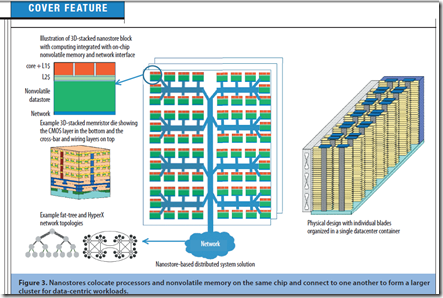This is month old news, but I missed it so I figured many of you did too.
HP's corporate blog has a post on future server design for where data centers are going for the big guys.
HP nanotechnology research looks to sustain HP server market leadership for the long run
by ETHAN BAULEY (Ethan_Bauley) a month ago - last edited a month ago
(Update: read the 2/28/11 The New York Times story "Remapping Computer Circuitry to Avert Impending Bottlenecks" for more on this subject)
“What will future computer systems look like?” asks HP Labs distinguished technologistParthasarathy Ranganathan in a cover story for Computer magazine, the flagship publication of the IEEE Computer Society.
In his article [PDF], Ranganathan suggests computer science is at what he calls an ‘inflection point,’ one that will provoke a radical rethink of traditional computer system design.
In the PDF, there are mentions of the big guys in data centers - Google, Microsoft, Facebook, Yahoo, and Amazon.
Recent data-centric workloads have been characterized by
numerous commercially deployed innovations in the software
stack—for example, Google’s BigTable and MapReduce, Amazon’s
Dynamo, Yahoo’s PNUTS, Microsoft’s Dryad, Facebook’s Memcached,
and LinkedIn’s Voldemort. Indeed, according to a recent
presentation, the software stack behind the very successful Google
search engine was significantly rearchitected four times in the past
seven years to achieve better performance at increased
scale.
The growing importance of this class of workloads,
their focus on large-scale distributed systems with
ever-increasing memory use, the potential inadequacy
of existing architectural approaches, and the
relative openness to software-level innovations in the
emerging workloads offer an opportunity for a corresponding
clean-slate architecture design targeted at
data-centric computing.
The HP server designed was covered in the NYTimes.
Remapping Computer Circuitry to Avert Impending Bottlenecks
By JOHN MARKOFF
PALO ALTO, Calif. — Hewlett-Packard researchers have proposed a fundamental rethinking of the modern computer for the coming era of nanoelectronics — a marriage of memory and computing power that could drastically limit the energy used by computers.
Noah Berger for The New York Times
BIG NEW IDEA Parthasarathy Ranganathan and his prototype of a data center.
Today the microprocessor is in the center of the computing universe, and information is moved, at heavy energy cost, first to be used in computation and then stored. The new approach would be to marry processing to memory to cut down transportation of data and reduce energy use.
Note the last mention of "reduce energy use." Green data center ideas are no longer as rare as they used to be.

